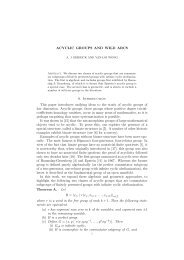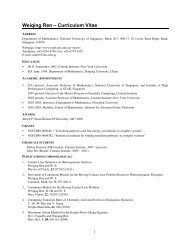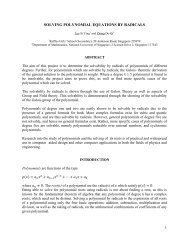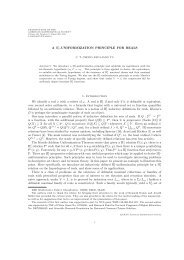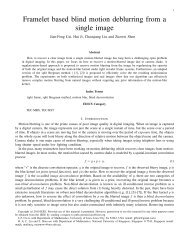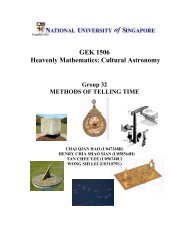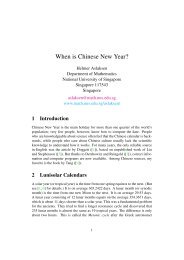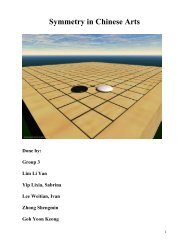Sun and Architecture
Sun and Architecture
Sun and Architecture
Create successful ePaper yourself
Turn your PDF publications into a flip-book with our unique Google optimized e-Paper software.
GEK 1506 HEAVENLY MATHEMATICS<br />
Group 66<br />
HEAVENLY MATHEMATICS<br />
GEK 1506<br />
<strong>Sun</strong> <strong>and</strong> <strong>Architecture</strong><br />
Lee Jin You, Roger U024711R<br />
Lee Ji Hao, Theophilus U024730X<br />
Lim Guang Yong U024732W<br />
Lim Ghim Hui U024718X<br />
Lim ShuEn Adele U024757W<br />
Lim Wee Kee U024699E<br />
SP<br />
66<br />
GRP<br />
&Aki
GEK 1506 HEAVENLY MATHEMATICS<br />
1.0 Introduction<br />
1.1 Rotation<br />
1.2 Revolution<br />
1.3 Equinox<br />
1.4 Solstice<br />
1.5 Season<br />
1.6 <strong>Sun</strong>’s apparent motion<br />
2.0 <strong>Sun</strong> Path<br />
TABLE OF CONTENTS<br />
2.1 Factors affecting changes in <strong>Sun</strong> Path<br />
2.2 <strong>Sun</strong> Path Diagrams<br />
2.3 Effects of <strong>Sun</strong> Path<br />
2.4 Shade Dial<br />
3.0 <strong>Sun</strong>light <strong>and</strong> Architectural Design<br />
3.1 <strong>Sun</strong>light as a source of lighting<br />
3.2 The shading effect<br />
3.3 The sun as a source of heat<br />
4.0 <strong>Sun</strong>dials<br />
4.1 Polar <strong>Sun</strong> Dial<br />
5.0 Heliodon<br />
5.1 Introduction<br />
5.2 <strong>Sun</strong>light Heliodons<br />
5.3 Artificial Light Heliodons<br />
5.4 Usefulness<br />
5.5 Theory <strong>and</strong> Application of Our Model<br />
SP<br />
66<br />
GRP<br />
&Aki
GEK 1506 HEAVENLY MATHEMATICS<br />
1.0 INRODUCTION<br />
SUN AND ARCHITECTURE<br />
SP<br />
66<br />
GRP<br />
&Aki<br />
The sun is the brightest star in the Earth’s solar system. Not only does the sun give us<br />
light, but is also a valuable source of heat energy. The sun can be considered the ‘life<br />
giver’ of all living things on Earth, for without the sun, many living organisms would<br />
cease to exist. However, the sun does create some problems for us. For example,<br />
extreme heat is undesirable as it may cause a sudden increase in bodily temperature.<br />
Hence, people have always sought ways to harness the sun’s power <strong>and</strong> yet at the same<br />
time reduce the detrimental effects of it. Before explaining the part on how architects<br />
come up with designs of buildings to control the sun’s energy, it is important to give a<br />
short summary of the relationship between the sun <strong>and</strong> the earth as this will affect the<br />
architects’ knowledge of the sun’s effect on building design.<br />
1.1 ROTATION<br />
The Earth rotates about on a fixed plane that is tilted 23.5° with respect to its vertical axis<br />
around the sun. The Earth needs 23hrs 56mins to complete one true rotation, or one<br />
sidereal period, around the sun. A sidereal day (period) is the time taken for a given<br />
location on the earth which is pointing to a certain star to make one full rotation <strong>and</strong><br />
return back pointing to the same star again. Since the speed of the Earth’s rotation is<br />
constant throughout the year, the Earth’s sidereal day will always be 23hrs 56mins. The<br />
solar day, on the other h<strong>and</strong>, is the time needed for a point on earth pointing towards a<br />
particular point on the sun to complete one rotation <strong>and</strong> return to the same point. It is<br />
defined as the time taken for the sun to move from the zenith on one day to the zenith of<br />
the next day, or from noon today to noon tomorrow. The length of a solar day varies, <strong>and</strong><br />
thus on the average is calculated to be 24hrs. In the course of the year, a solar day may<br />
differ to as much as 15mins. There are three reasons for this time difference. Firstly it is<br />
because the earth’s motion around the <strong>Sun</strong> is not perfect circle but is eccentric. The<br />
second reason is due to the fact that the <strong>Sun</strong>’s apparent motion is not parallel to the<br />
celestial equator. Lastly, the third reason is because of the precession of the Earth’s axis.<br />
For simplicity, we averaged out that the Earth will complete one rotation every 24hrs<br />
(based on a solar day) <strong>and</strong> thus moves at a rate of 15° per hour (one full rotation is 360°).<br />
Because of this, the sun appears to move proportionately at a constant speed across the<br />
sky. The sun thus produces a daily solar arc, which is the apparent path of the sun’s<br />
motion across the sky. At different latitudes, the sun will travel across the sky at different<br />
angles each day. Greater detail about this phenomenon will be touch on in the later part<br />
of the section.
GEK 1506 HEAVENLY MATHEMATICS<br />
SP<br />
66<br />
GRP<br />
&Aki<br />
The rotation of the earth about its axis also causes the day <strong>and</strong> night phenomenon. The<br />
length of the day <strong>and</strong> night depends on the time of the year <strong>and</strong> the latitude of the location.<br />
For places in the northern hemisphere, the shortest solar day occurs around December 21<br />
(winter solstice) <strong>and</strong> the longest solar day occurs around June 21 (summer solstice)<br />
(Figure 1.2). In theory, during the time of the equinox, the length of the day should be<br />
0equal to the length of the night. This will be further discussed in the later part too.<br />
1.2 REVOLUTION<br />
Figure 1.1 Different angles of the sun<br />
It is generally accepted that the earth’s complete revolution around the <strong>Sun</strong> is 365 days.<br />
However, to be exact, the number of days the earth takes to revolve around the sun<br />
actually depends on whether we are referring to a sidereal year or a tropical (solar) year.<br />
A sidereal year is the time taken for the earth to complete exactly one orbit around the<br />
<strong>Sun</strong>. A sidereal year is then calculated to be 365.2564 solar days. A tropical year is the<br />
time interval between two successive vernal equinoxes, which is 365.2422 solar days.<br />
The difference between the two is that tropical year takes into consideration precession<br />
but the sidereal year does not. Precession is the event where the earth’s axis shifts<br />
clockwise in circular motion which then changes the direction when the North Pole is<br />
pointing.<br />
The difference between the sidereal <strong>and</strong> the tropical year is 20mins. This difference is<br />
negligible in the short run, but in the long run will cause time calculation problems. Thus<br />
readjustments to calendars must be made to correct this difference. Hence for simplicity,<br />
the average time the earth takes to move around the sun in approximately 365 days. This<br />
path that the earth takes to revolve around the sun is called the elliptical path.
GEK 1506 HEAVENLY MATHEMATICS<br />
Spring (Vernal) Equinox<br />
SP<br />
66<br />
GRP<br />
&Aki<br />
Summer solstice Winter solstice<br />
1.3 EQUINOX<br />
Autumnal (Fall) Equinox<br />
Figure 1.2 Solstices <strong>and</strong> Equinoxes<br />
To explain solstices, equinoxes <strong>and</strong> season, it will be easier if we use the heliocentric<br />
model. Equinoxes happen when the ecliptic (sun’s apparent motion across the celestial<br />
sphere) <strong>and</strong> celestial equator intersect. When the sun is moving down from above the<br />
celestial equator, crosses it, then moves below it, that point of intersection between the<br />
two planes is when the Autumnal Equinox occurs. This usually happens around the 22 nd<br />
of September. When the <strong>Sun</strong> moves up from below the celestial equator to above it, the<br />
point of intersection between the sun <strong>and</strong> the celestial equator is when Spring (Vernal)<br />
Equinox occurs. It usually happens around the 21 st of March. During the equinoxes, all<br />
parts of the Earth experiences 12 hours of day <strong>and</strong> night <strong>and</strong> that is how equinox gets it<br />
name as equinox means “equal night”. At winter solstice (Dec), the North Pole is inclined<br />
directly away from the sun. 3 months later, the earth will reach the date point of the<br />
March equinox <strong>and</strong> that the sun’s declination will be 0°. 3 months later, the earth will<br />
reach the date point of the summer solstice. At this point it will be at declination -23.5°.<br />
This cycle will carry on, creating the seasons that we experience on earth (Figure 1.2).
GEK 1506 HEAVENLY MATHEMATICS<br />
1.4 SOLSTICE<br />
SP<br />
66<br />
GRP<br />
&Aki<br />
The earth is tilted 23.5 o , so is the ecliptic, with respect to the celestial equator, therefore<br />
the <strong>Sun</strong> maximum angular distance from the celestial equator is 23.5°. At the summer<br />
solstice which occurs around 21 st of June, the North Pole is pointing towards the sun at an<br />
angle of 23.5 o as shown in figure 1.3. Therefore the apparent declination of the sun is<br />
positive 23.5 o with respect to the celestial equator. At the Winter solstice which occurs<br />
around 21 st December, the North Pole is pointing away from the sun at an angle of 23.5 o .<br />
Therefore the apparent declination of the sun is negative 23.5 o with respect to the<br />
celestial equator.<br />
1.5 SEASON<br />
Seasons are caused by the Earth axis which is tilted by 23.5 o with respect to the ecliptic<br />
<strong>and</strong> due to the fact that the axis is always pointed to the same direction. When the<br />
northern axis is pointing to the direction of the <strong>Sun</strong>, it will be winter in the southern<br />
hemisphere <strong>and</strong> summer in the northern hemisphere. Northern hemisphere will<br />
experience summer because the <strong>Sun</strong>’s ray reached that part of the surface directly <strong>and</strong><br />
more concentrated hence enabling that area to heat up more quickly. The southern<br />
hemisphere will receive the same amount of light ray at a more glancing angle, hence<br />
spreading out the light ray therefore is less concentrated <strong>and</strong> colder. The converse holds<br />
true when the Earth southern axis is pointing towards the <strong>Sun</strong>. (Figure 1.5)<br />
Figure 1.5 Tilt of the earth
GEK 1506 HEAVENLY MATHEMATICS<br />
1.6 SUN’S APPARENT MOTION<br />
SP<br />
66<br />
GRP<br />
&Aki<br />
From the heliocentric point of view, the Earth rotates <strong>and</strong> revolves around the sun in a<br />
counter clockwise direction. However, when we look at the <strong>Sun</strong> on earth, it appears to be<br />
moving in a clockwise direction. This phenomenon is known as the apparent motion of<br />
the sun.<br />
2.0 SUN PATHS<br />
2.1 INTRODUCTION<br />
Have you ever wondered why the sun rises in the east <strong>and</strong> sets in the west? For centuries,<br />
this natural phenomenon has always amazed mankind. Being the closest star to us, the<br />
sun certainly brings about a great interest for everyone to study its movement <strong>and</strong><br />
behavior, especially its position at different times of the day <strong>and</strong> month during the year.<br />
However, we first have to underst<strong>and</strong> that viewing the sun from different locations on the<br />
earth, the sun will rise <strong>and</strong> set from a different point on the horizon <strong>and</strong> move along<br />
different paths across the sky.<br />
Though knowing that the sun rises in the east <strong>and</strong> set in the west, do you know that the<br />
sun does not rise exactly due east or sets exactly due west? Instead the sun may rise<br />
further north of east or further south of east, depending on which part of the earth you are<br />
at. To underst<strong>and</strong> where you st<strong>and</strong> on the earth, it is specified by the latitude <strong>and</strong><br />
longitude coordinates.<br />
.<br />
On a globe model, lines of latitude are circles of different sizes. The largest circle is the<br />
equator, whose latitude is zero, while at the poles- at latitudes 90° north <strong>and</strong> 90° south (or<br />
-90°), the circles shrink to a point as shown below (Figure 2.1a). Whereas for longitude<br />
they are lines, or arcs, extend from pole to pole as shown in the diagram below (Figure<br />
2.1b).<br />
S<br />
Figure 2.1a Lines of Latitude Figure 2.1b Lines of Longitude
GEK 1506 HEAVENLY MATHEMATICS<br />
SP<br />
66<br />
GRP<br />
&Aki<br />
The base values for the latitude <strong>and</strong> longitude are the equator <strong>and</strong> the prime meridian<br />
respectively. The latitude <strong>and</strong> longitude will have significant effects on the sun path <strong>and</strong><br />
hence affects the behavior of the sun’s lighting <strong>and</strong> heating characteristics.<br />
After explaining the latitudes <strong>and</strong> longitude, we are going to position ourselves, as<br />
observers to be in the latitude of 0 degree <strong>and</strong> 90 degrees North. Now looking from an<br />
observer’s point of view, we will try to measure the position of the sun with reference to<br />
the horizon.<br />
To measure the angle of the sun in its motion across the sky, we need to take its altitude<br />
<strong>and</strong> azimuth reading. Altitude is the angular distance above the horizon measured<br />
perpendicularly to the horizon. It has a maximum value of 90 0 at the zenith, which is the<br />
point overhead. Azimuth the angular distance measured along the horizon in a clockwise<br />
direction. The number of degrees along the horizon corresponds to the compass direction.<br />
Azimuth starts from exactly north, at 0 degrees, <strong>and</strong> increases clockwise. The example<br />
below illustrates the sun angles for 56 degrees North latitude (Northern Hemisphere). The<br />
altitude as you can see from the figure below is symbolized by β starts from the horizon<br />
while the azimuth is symbolized by α which starts from the South Pole <strong>and</strong> travels<br />
clockwise.<br />
β = Altitude<br />
α = Azimuth<br />
Horizon<br />
Figure 2.1c Azimuth <strong>and</strong> Altitude<br />
β<br />
β
GEK 1506 HEAVENLY MATHEMATICS<br />
2.2 FACTORS THAT CAUSES THE CHANGE IN SUN PATHS<br />
Figure 2.2a<br />
Figure 2.2b<br />
SP<br />
66<br />
GRP<br />
&Aki<br />
Depending on the day of the year <strong>and</strong> the latitude of the observer, it affects where the sun<br />
exactly rises or sets, or how long the sun is above the horizon. As seen from the 2<br />
diagrams above the sun does not necessarily rise due East or set due west. The location of<br />
the sun in the sky is described as having two components: its daily movement around the<br />
horizon <strong>and</strong> its height above the horizon (altitude). Its altitude varies with the seasons <strong>and</strong><br />
location of the observer. At 40 degrees latitude, Figure 2.2a, during the equinox the sun<br />
rises due east, while during solstices the sun rises due south east or north east. At 65<br />
degrees latitude, Figure 2.2b, the sun rises further south of east during the winter solstice<br />
<strong>and</strong> further north of east during the summer solstice.<br />
The sun’s daily path across the sky on or about the 21 st day of each month is indicated by<br />
means of seven curved lines. The path is highest in June <strong>and</strong> the lowest in December. The<br />
sun travels across the earth’s sky along 7 main paths. Each of the other five paths is for<br />
two months in the year. For instance, the path on the March 21 is the same as on<br />
September 23.<br />
We observe the sun in the northern hemisphere with regards to its paths. The tilt of the<br />
earth causes the seasons which constitutes the difference in the sun paths.<br />
The sun paths are different due to factors such as the:<br />
1) Location (local latitude)<br />
2) Rising <strong>and</strong> setting position (based on the time of the year)<br />
3) Duration of the day <strong>and</strong> night
GEK 1506 HEAVENLY MATHEMATICS<br />
Figure 2.2c The sun in the sky in the northern hemisphere<br />
SP<br />
66<br />
GRP<br />
&Aki<br />
During the summer solstice, on the 21 st of June, the sun will be traveling at the highest<br />
path across the sky (shown as the red line). In the morning, the sun will rise due north of<br />
east, th n crosses the meridian due south at noon <strong>and</strong> setting a little due north of west.<br />
The duration of the day is longer relative to the night as the sun across the sky. The sun’s<br />
maxim titude will occur at noon (calculated by the latitude of the observer’s location<br />
plus 23.5 o) e<br />
um al<br />
.<br />
Each day the path of the sun becomes lower until the day when the duration is exactly 12<br />
hours; this will be the September equinox, 21 st September (shown as purple line). The sun<br />
will rise at exact east <strong>and</strong> set at exact west.<br />
The sun path is the lowest in the sky during the winter solstice. The sun will rise south of<br />
East <strong>and</strong> set at the south of West in any of the day in that time of the year. It reaches<br />
nearest to South at noon. The duration of the day will be much shorter relative<br />
to the<br />
Summer Solstices <strong>and</strong> September Equinox. As the earth proceeds into the March equinox,<br />
the altitude of the sun will gradually be higher. The duration of the day will increase to<br />
eventually 12 hours at the equinox (shown as purple line above).<br />
The ever changing path of the <strong>Sun</strong> is a result of our seasons. The earth as a whole<br />
receives the same amount of sunlight everyday <strong>and</strong> every year. The apparent movement<br />
of the sun around the earth is relative <strong>and</strong> due to the earth’s rotation <strong>and</strong> orbit. The<br />
seasonal differences<br />
in the daily path of the sun are due to the tilt of the earth’s axis.
GEK 1506 HEAVENLY MATHEMATICS<br />
2.3 SUN PATHS DIAGRAM<br />
SP<br />
66<br />
GRP<br />
&Aki<br />
<strong>Sun</strong> path diagrams are a convenient way of representing the annual changes in the path of<br />
the <strong>Sun</strong> through the sky on a single 2D diagram. Their most immediate use is that the<br />
solar azimuth <strong>and</strong> altitude can be read off directly for any time of the day <strong>and</strong> month of<br />
the year. They also provide a unique summary of solar position that the architect can refer<br />
to when considering shading requirements <strong>and</strong> design options. There are quite a few<br />
different types of sun-path diagrams, however, we will only examine two main forms.<br />
The Stereographic Diagrams<br />
Stereographic<br />
diagrams are used to represent the sun's changing position in the sky<br />
through out the day <strong>and</strong> year. In form, they can be likened to a photograph of the sky,<br />
taken looking straight up towards the zenith,<br />
with a 180° fish eye lens. The paths of the<br />
sun at different times of the year can then be projected onto this flattened hemisphere for<br />
any location on Earth.<br />
A basic full stereographic diagram, with all its components is shown below.<br />
Source: www.squ1.com/solar/sun-path-diagrams.html
GEK 1506 HEAVENLY MATHEMATICS<br />
Azimuth Lines <strong>and</strong> Altitude Lines<br />
SP<br />
66<br />
GRP<br />
&Aki<br />
Azimuth angles run around the edge of the diagram in 15° increments. A point's azimuth<br />
from the reference position is measured in a clockwise direction from True North on the<br />
horizontal plane. True North on the stereographic diagram is the positive Y axis (straight<br />
up) <strong>and</strong> is marked with an N.<br />
Altitude angles are represented as concentric circular dotted lines that run from the<br />
centre of the diagram out, in 10° increments from 90 to 0. A point's altitude from the<br />
reference position is measured from the horizontal plane up.<br />
Date Lines <strong>and</strong> Hour Lines<br />
Date lines represent the path of the sun through the sky on one particular day of the year.<br />
They start on the eastern side of the graph <strong>and</strong> run to the western side. There are twelve<br />
of these lines shown, for the 1st day of each month. The first six months are shown as<br />
solid lines (Jan-Jun) whilst the last six months are shown as dotted (Jul-Dec), to allow a<br />
clear distinction even though the path of the <strong>Sun</strong> is cyclical.<br />
Hour lines represent the position of the sun at a specific hour of the day, throughout the<br />
year. They are shown as figure-8 type lines (Analemma) that intersect the date lines. The<br />
intersection points between the date <strong>and</strong> hour lines give the position of the sun. Half of<br />
each hour line is shown as dotted, to indicate that this is during the latter six months of<br />
the year.<br />
Reading the <strong>Sun</strong> Position<br />
The position of the <strong>Sun</strong> in the sky at any time of the day on any day of the year can be<br />
read directly from the diagram above. First you need to locate the required hour line on<br />
the diagram. Then locate the required date line, remembering that solid are used for Jan-<br />
Jun <strong>and</strong> dotted lines for Jul-Dec.
GEK 1506 HEAVENLY MATHEMATICS<br />
Follow the steps below to read the <strong>Sun</strong> position from a stereographic sun-path diagram:<br />
� Step 1 - Locate the required hour line on the diagram.<br />
� Step 2 - Locate the required date line, remembering that solid are used for Jan-<br />
Jun <strong>and</strong> dotted lines for Jul-Dec.<br />
� Step 3 - Find the intersection point of the hour <strong>and</strong> date lines. Remember to<br />
intersect solid with solid <strong>and</strong> dotted with dotted lines.<br />
� Step 4 - Draw a line from the very centre of the diagram, through the intersection<br />
point, out to the perimeter of the diagram.<br />
� Step 5 - Read the azimuth as an angle taken clockwise from North. In this case,<br />
the value is about 62°.<br />
� Step 6 - Trace a concentric circle<br />
around from the intersection point to the vertical<br />
North axis, on which is displayed the altitude angles.<br />
� Step 7 - Interpolate between the concentric circle lines to find the altitude. In this<br />
case the intersection<br />
point sits exactly on the 30° line.<br />
This gives the position<br />
of the sun, fully defined as an azimuth <strong>and</strong> altitude.<br />
Cylindrical Diagrams<br />
SP<br />
66<br />
GRP<br />
&Aki<br />
A cylindrical projection is simply a 2D graph of the <strong>Sun</strong><br />
position in Cartesian coordinates.<br />
The azimuth is plotted along the horizontal axis whilst the altitude is plotted<br />
vertically. Reading off positions is simply a matter of reading off the two axis, as shown<br />
below.
GEK 1506 HEAVENLY MATHEMATICS<br />
Follow the steps below to read the <strong>Sun</strong> position from a cylindrical sun-path diagram:<br />
� Step 1 - Locate the required<br />
hour line on the diagram.<br />
� Step 2 - Locate the required date line, remembering that solid are used for Jan-<br />
Jun <strong>and</strong> dotted lines for Jul-Dec. In these diagrams, the highest altitude line at<br />
noon is always in midsummer (either 1st July or 1st Jan, depending on<br />
hemisphere). Each other line represents the 1st of each month, solid Jan-Jun,<br />
dotted Jul-Dec.<br />
� Step 3 - Find the intersection point of the hour <strong>and</strong> date lines. Remember to<br />
intersect solid with solid <strong>and</strong> dotted with dotted lines.<br />
� Step 4 - The azimuth is given by reading off the horizontal axis. In this case, the<br />
value is about 62°.<br />
� Step 5 - The altitude is given by reading off the vertical axis. In this case the<br />
intersection point sits almost exactly on the 30° line.<br />
2.4 The Shade Dial<br />
SP<br />
66<br />
GRP<br />
&Aki<br />
With the shade dial, the shading effect or insolation can be determined on the models at<br />
any geographical location <strong>and</strong> at any given time. By placing the shade dial near <strong>and</strong> on<br />
the same surface with the model, we will be able to orientate them as related to the light<br />
source so that the actual position of the insolation will be produced.<br />
Month/ date<br />
Semic ircular<br />
dial<br />
Stick with a<br />
rounded head<br />
Shadow<br />
(Date <strong>and</strong> Time)<br />
Figure 2.4 Shade Dial<br />
Time<br />
Knob<br />
St<strong>and</strong>
GEK 1506 HEAVENLY MATHEMATICS<br />
SP<br />
66<br />
GRP<br />
&Aki<br />
The shade dial is made of mainly a semicircular dial, a stick with a rounded head, a on<br />
the side of the dial <strong>and</strong> a st<strong>and</strong>.<br />
y <strong>and</strong> the days of the<br />
onth according to the declination (23.5 ). The hour lines of the dial are<br />
arked at 15 0 intervals hourly due of the earth as discussed above. As for<br />
the date lines, they are divided into pproximately an interval every 10 days<br />
e 1 st , 11 th <strong>and</strong> the 21 st .Due to the nature of the sun path, each date line will<br />
represent 2 dates (except for the solstices) when the declination of the sun is the same.<br />
ple, 21 st February will share the same date line as 21 st The semicircular dial is calibrated for the seasonal <strong>and</strong> hourly changes <strong>and</strong> is indicated on<br />
the surface of the dial itself. On the dial, it shows the hours of the da<br />
o<br />
m of the sun<br />
m<br />
to the rotation<br />
3 per month, a<br />
or on th<br />
For exam<br />
October. That is why the<br />
date lines<br />
run from December to June (top down) on the left side of the shade dial <strong>and</strong> run<br />
from June to December (bottom up) on the right.<br />
However, the indication is not very exact because of the irregularities<br />
between the<br />
astronomical<br />
data <strong>and</strong> the calendar year (shown in the table<br />
below). The difference is<br />
very small that is why it is negligible.
GEK 1506 HEAVENLY MATHEMATICS<br />
SP<br />
66<br />
GRP<br />
&Aki<br />
The stick with rounded head is fitted at the center of the dial. Once illuminated, it will<br />
cast a shadow on the dial. The shadow cast will show the month <strong>and</strong> the time of the day<br />
on the dial, which will correspond to the situation of the sun at that particular time. On<br />
the other h<strong>and</strong>, if we are interested in the insolation at a particular day <strong>and</strong> time, we could<br />
adjust accordingly <strong>and</strong> we will see the illumination of the model eventually.<br />
The knob on the side of the dial is to adjust the position as to simulate the difference in<br />
the geographical location (latitude). Thus the shade dial is usable in any latitude. When<br />
the knob shows “North latitude”, it refers to the northern hemisphere. Thus the knob must<br />
be turned to the correct latitude to simulate the actual location of the l<strong>and</strong>.<br />
The shade dial is usable in both the day time as well as the night time. To measure during<br />
0<br />
the night, simply turn the shade dial 180 <strong>and</strong> the south signal will be parallel to the<br />
model. The shade dial not only makes the study of the distribution of shade <strong>and</strong> sunshine<br />
possible, but it is also capable of showing the insolation is necessary or not. The shade<br />
dial is able to show us whether the period<br />
is “under heated” or “overheated”. The shade<br />
dial ca n be used as a chart, with the hour line as abscissa <strong>and</strong> the seasonal<br />
declination as<br />
the ordinate.<br />
The overheated area will be translated onto the chart. Therefore, the shade<br />
dial<br />
is able to determine the direction of shading <strong>and</strong> able to show us whether the shading<br />
on<br />
the building is desirable or not. Same as above, the date lines represent 2 dates in a<br />
year.<br />
Therefore, overheated period are area that have darker tones so shading is required<br />
for<br />
both the dates. As for the lighter tones, shading is required for only one of the dates.<br />
Lighter<br />
tones<br />
Darker<br />
tones<br />
When setting up the shade dial, much care must be emphasized on the orientation of the<br />
shade dial <strong>and</strong> the model; both are facing the same direction. For an example, the south<br />
sign of the model must be parallel to the sign indicated on the knob.
GEK 1506 HEAVENLY MATHEMATICS<br />
As shown in the figure above, the angle of the shade dial is equal to the geographical<br />
location of the model. For example, tilting of knob to 45 o represents the latitude 45 o .<br />
Figure 2.4.1 Shade dial <strong>and</strong> Model of house<br />
SP<br />
66<br />
GRP<br />
&Aki
GEK 1506 HEAVENLY MATHEMATICS<br />
3.0 SUNLIGHT AND ARCHITECTURAL DESIGNS<br />
SP<br />
66<br />
GRP<br />
&Aki<br />
Mankind has always sought ways to harness the power of the sun for their daily needs<br />
<strong>and</strong> uses. In designing buildings <strong>and</strong> structures, architects have constantly focused their<br />
attention towards the sun. The sun has been both a bane as well as an aid for building<br />
designers: too much sunlight will lead to excessive heating. On the other h<strong>and</strong>,<br />
incorporated properly into the design of the building, sunlight can be used as a<br />
complement to light interior facades <strong>and</strong> rooms. Hence architects today must not only<br />
design buildings to collect energy from the sun to provide heating <strong>and</strong> lighting, but also<br />
to reject solar energy when is can lead to overheating of the building. This is known as<br />
passive solar architecture. Passive solar design main goals are to reduce the fossil fuel<br />
consumption of buildings as well as produce buildings that act in conjunction with<br />
natural forces <strong>and</strong> not against them.<br />
This report aims to explain how architects, based on their knowledge of the sun <strong>and</strong> the<br />
sun’s path, design a building so that the building can fully utilize the available solar<br />
energy. We will discuss three aspects of passive solar design: the lighting consideration,<br />
the shading consideration <strong>and</strong> the heating consideration. These 3 aspects largely affect<br />
the overall performance of the building in terms of occupational <strong>and</strong> functional<br />
requirements.<br />
equirements.<br />
3.1 <strong>Sun</strong>light as a source of Lighting<br />
O n a clear <strong>and</strong> bright day, the sun, combined with the reflective qualities of the clear sky,<br />
g ives off about 8,000 to 10,000 footc<strong>and</strong>les of light. During any normal day, be it<br />
overcast or clear, there is almost always enough light available from the sun <strong>and</strong> sky to<br />
provide illumination for most human visual tasks. However, due to constantly changing<br />
cloud cover, the amount of illumination varies from time to time. Hence it is almost<br />
impossible to predict with precision what the interior daylighting conditions in any<br />
building will be like at any given moment. Nonetheless, the architect should at least have<br />
on h<strong>and</strong> a rough range of expected daylight conditions based on the sun’s behavior at that<br />
particular location.<br />
The main aims in daylighting a building are to (1) get significant quantities of daylight as<br />
deep into the building as possible, (2) to maintain a uniform distribution of daylight from<br />
one area to another, <strong>and</strong> (3) to avoid<br />
visual discomfort <strong>and</strong> glare. Along with<br />
these objectives in mind, the architect<br />
will design a building according to the<br />
su n’s behavior at that particular latitude.<br />
The two main ways arc hitects control the<br />
e ffects of the sun on the building is<br />
th rough the orientation of the building<br />
a nd the overall design structural layout.<br />
Figure 3.1 Daylighting within a building
GEK 1506 HEAVENLY MATHEMATICS<br />
SP<br />
66<br />
GRP<br />
&Aki<br />
First an d foremost, sunlight can only be used as a complement to artificial lighting <strong>and</strong><br />
not<br />
as a main source of light. It is up to architects to design buildings so as to capture as<br />
much sunlight as possible <strong>and</strong> thus reduce the amount of energy consumption. Depending<br />
on the function of the building, the building may or may not be orientated to face the sun.<br />
For example, most residential buildings are orientated away from the east-west axis as the<br />
rays from the low morning <strong>and</strong> evening sun can penetrate directly into the building <strong>and</strong><br />
cause glare discomfort. On the other h<strong>and</strong>, commercial buildings may be orientated to<br />
capture these long sun rays for aesthetical reasons.<br />
Another way architects can control the amount of daylighting in a building is through the<br />
actual design structure of the building itself- the use of structural designs <strong>and</strong> concepts to<br />
allow sunlight penetration. Sometimes buildings are designed with large glass facades to<br />
allow maximum sunlight penetration into the building, <strong>and</strong> these facades are usually<br />
orientated<br />
to slightly face the sun. For most residential buildings, openings such as doors<br />
<strong>and</strong> windows are preferably not placed along the east-west axis. In commercial buildings,<br />
certain areas are left empty on purpose so that sunlight is allowed into the building<br />
envelope with minimum obstructions. Take for example a museum with a sky vault in<br />
the northern hemisphere. During the summer months when the sun is high in the sky, the<br />
sun will be able to shine directly into the building through the sky vault. But during the<br />
winter months, depending on the size of the sky vault, the sun may not be able to shine<br />
directly<br />
onto the museum’s floor. Hence there may be a need to increase artificial<br />
lighting<br />
for the various exhibits in the museum. This is a factor that architects may have<br />
to consider when designing the museum.<br />
3.2 The Shading Effect<br />
The sun will always cast a shadow on any object. Only the length, shape <strong>and</strong> size of the<br />
shadow will change with respect to the sun’s position in the sky throughout the year.<br />
When designing buildings, it is important to notice the amount of shade cast on the<br />
building, or otherwise how its shadow will affect its surroundings. As mentioned earlier<br />
above, at different latitudes, the sun will<br />
travel along different<br />
paths across the sky at<br />
different<br />
times of the year. The sun’s<br />
peculiar behavior is a very important factor<br />
when designing <strong>and</strong> constructing buildings.<br />
For locations which are at latitudes away<br />
from the equator, during the summer months,<br />
the sun will cast relatively short shadows<br />
while during the winter months, the sun will<br />
cast long shadows of objects. In the<br />
equatorial region, the sun’s path remains<br />
relatively unchanged hence the length of the<br />
shadows does not vary much throughout the<br />
year.<br />
Depending<br />
on the function of the building,<br />
Figure 3.2.1 Shading Devices
GEK 1506 HEAVENLY MATHEMATICS<br />
3.3<br />
The sun as a heat source<br />
SP<br />
66<br />
GRP<br />
&Aki<br />
sunlight is either filtered out or allowed to penetrate into the building envelope. Most of<br />
the time, sunlight is filtered out or prevented from reaching the interior facades of the<br />
building. This is done by using three main methods of shading: using natural devices,<br />
internal devices, <strong>and</strong> external devices. Natural devices include shading by trees <strong>and</strong><br />
shrubs. For example, deciduous plants have the advantage of providing shade during the<br />
winter <strong>and</strong> spring months- most trees give shade only during summer <strong>and</strong> early autumn as<br />
they shed most of their crown during the winter <strong>and</strong> spring. During the winter months<br />
(sun is low in the sky), these trees are able to block out the low rays <strong>and</strong> hence effectively<br />
shading<br />
the building. Internal devices include curtains <strong>and</strong> blinds that are installed within<br />
the building itself. These devices are able to give occupants flexibility as to how much<br />
sunlight is allowed into the building because the occupants are able to physically control<br />
theses devices. Lastly, external devices include structural elements such as overhangs<br />
<strong>and</strong> louvers that are fixed to the building during construction. These devices are<br />
permanent <strong>and</strong> hence will have different effective shading qualities as the sun’s position<br />
in the sky is constantly changing. In closing, architects can make use of these 3 devices<br />
to effectively shield the building from the sun’s rays.<br />
With regards to the shadow that the building will cast on its surroundings, this is<br />
determined using a heliodon. This further explained in the next section. An entire model<br />
city l<strong>and</strong>scape is constructed <strong>and</strong> is then subjected to testing against different angles of<br />
light. The effect of the shadow cast on the surrounding areas is very evident. From there,<br />
architects are able to determine shading effects on different buildings.<br />
Lastly,<br />
the sun is a valuable source of heat energy. Similar to light, the sun’s natural heat<br />
may be wanted or unwanted. Countries in the tropics do not want excessive heating from<br />
the sun while higher latitude countries welcome the sun’s warmth during the winter<br />
months. Hence, the amount of heating required depends largely again on the latitude <strong>and</strong><br />
the function of the building. Once again, the orientation of the building as well as the<br />
structural elements used in the design of the building<br />
play an active role in controlling the<br />
sun’s heat. For example, buildings with overhangs are able to provide shade during the<br />
summer months- the sun is unable to reach within the building. However, during the<br />
winter months, the sun is allowed to penetrate<br />
through the building envelope.<br />
Figure 3.3 Different angles of<br />
the sun
GEK 1506 HEAVENLY MATHEMATICS<br />
4.0 SUNDIALS<br />
One of the oldest techniques to know the time<br />
is the direct observation of the sun to get its<br />
height or the direction above special l<strong>and</strong>marks.<br />
This is by means of using sundials.<br />
The sundial dates back to the Egyptian Period,<br />
around 1500 B.C. It was also used in ancient<br />
Greece <strong>and</strong> Rome. The ancient Eyptians<br />
created simple sundials. These sundials were<br />
built with two boards which were put together<br />
to form a fallen “L” (Figure 4.0) so that the<br />
SP<br />
66<br />
GRP<br />
&Aki<br />
smaller board could throw a shadow on to the longer Figure 4.0 “L” shaped sundial<br />
one. The marks on the horizontal board measures the<br />
time.<br />
In 1500 BC the ancient Egyptians created simple sundials. In central Europe it was<br />
the<br />
most commonly used method to determine the time, even after the mechanical clock<br />
was developed in the 14th century. The<br />
sundial was actually used to check <strong>and</strong> adjust the<br />
time<br />
on mechanical clocks until late into the<br />
19th century where the sundials get better<br />
<strong>and</strong> a new science was created: the Gnomonic science of sundials.<br />
The Greek word gnomon means something like judger (of the time). There are different<br />
types of sundials. The four most popular ones are the horizontal sundial, the vertical<br />
sundial, the equatorial sundial <strong>and</strong> the polar sundial. All that kinds of sundials have one<br />
thing in common; the angle of inclination of the gnomon (Gn) is always equal with the<br />
latitude (f) of place.<br />
The polar sundial is selected to for use in our experiment to observe the effects of the<br />
sun’s<br />
movement on the design <strong>and</strong> orientation of architectural buildings because of its<br />
ability<br />
to tell the time of the day as well as the month of the year.<br />
4 .1 The Polar <strong>Sun</strong>dial<br />
The<br />
Earth rotates on a tilted axis <strong>and</strong> the speed of its orbit changes, the sun appears to<br />
move<br />
across the sky at slightly different rates throughout the year. This means that the<br />
time<br />
is measured by a sundial can be up to 16 minutes faster or slower than the time<br />
measured<br />
by a clock. To establish a move uniform unit of time, an average or Mean Solar<br />
Day<br />
was adopted.
GEK 1506 HEAVENLY MATHEMATICS<br />
SP<br />
66<br />
GRP<br />
&Aki<br />
The gnomon or style (which casts the shadow) is the "oxhead" in the centre of the dial. At<br />
6 am, the shadow from the top of the gnomon just skims the top of the left h<strong>and</strong> side of<br />
the<br />
sundial. By 6.45am the shadow has traversed, <strong>and</strong> arrived on the main dial plate. It<br />
slowly<br />
moves across the dial. At noon, the sun is directly overhead, <strong>and</strong> the shadow is<br />
immediately<br />
below the gnomon in the centre of the dial plate <strong>and</strong> finally reaches the end<br />
of<br />
the dial plate at around 6pm. The hour markers on this type of sundial are very<br />
unevenly spaced. The formula is h / x = tan(hour angle), where 'h' is the hour <strong>and</strong> 'x' is<br />
the<br />
position on the X-axis.<br />
The latitude can be adjusted by moving the two<br />
plates which shows the angles on both<br />
‘ears’ of the dial plate according to the desired latitude. It<br />
is best to tilt the model no more<br />
than necessary. Depending on the desired<br />
location on the Earth (Northern or Southern<br />
Hemisphere),<br />
the polar sundial have to flipped accordingly.<br />
Month<br />
Gnomon<br />
Northern<br />
Hemisphere<br />
Fig 4.1<br />
A h<strong>and</strong>made polar sundial<br />
“Ear”<br />
Time of<br />
the day<br />
This is a small scale polar sundial used in building <strong>and</strong> arhictecture decisions making.<br />
There are many other big scale polar sun dials which measures time more accurately in<br />
the world. Below are some of the polar sun dials found in other parts of the world.
GEK 1506 HEAVENLY MATHEMATICS<br />
A polar sundial designed by Piers Nicholson<br />
The Greenwich polar sundial<br />
A commercial sun dial<br />
5.0<br />
HELIODON<br />
5.1 Introduction<br />
SP<br />
66<br />
GRP<br />
&Aki<br />
Heliodons or “sun machines" are developed for the testing of sunlight effects on physical<br />
models, aiming at reproducing the actual direction of sunlight in relation to a building.<br />
Typically<br />
these studies seek to examine shading devices that eliminate direct sun from
GEK 1506 HEAVENLY MATHEMATICS<br />
areas where visual tasks are critical. Direct sun can cause problems of heat gain <strong>and</strong><br />
debilitating<br />
glare.<br />
Fig. 1 a D & B heliodon<br />
SP<br />
66<br />
GRP<br />
&Aki<br />
History<br />
The earliest report of heliodon (Fig. 1) was<br />
made by Dufton <strong>and</strong> Beckett of Building<br />
Research Station of UK in RIBA Journal of 16<br />
May 1931.<br />
In this D & B heliodon, the sunlight direction<br />
for various days was simulated with a lamp to<br />
be fixed at various positions of a vertical lamp<br />
holder. The model was placed at a tilted<br />
platform adjusted for the desired latitude at<br />
which the modeled building was built. The<br />
tilted platform is hinged at an angle = (90°-<br />
latitude angle) from a horizontal rotating plate.<br />
The rotating plate is marked with a circular<br />
scale of 24 hours for selecting the hour required<br />
for model testing. This plate rotates about a<br />
vertical axis parallel to the vertical lamp holder.<br />
Over<br />
the years heliodons have been built in a variety of configurations. In each case, the<br />
device creates the appropriate geometrical relationship between an architectural scale<br />
model<br />
<strong>and</strong> a representation of the sun. Heliodons are used to simulate the lighting<br />
conditions<br />
at:<br />
• A specific latitude (site location), which defines the sun-paths in relation to<br />
the geographical location<br />
• Time of year (seasonal variation), which related to the declination of the sun<br />
on a given day<br />
• And time of day (the earth’s rotation), which is the hourly change of the sun<br />
from East to West<br />
The result is a useful representation of solar patterns for clear sky conditions. Other<br />
techniques are often used in concert with heliodon simulations to account for variations<br />
in the strength of the sun (due to weather, angle of incidence, <strong>and</strong> atmospheric attenuation)<br />
<strong>and</strong> local horizon shading. Heliodons provide an effective tool for the visualization <strong>and</strong><br />
calculation of solar effects at the window, building, or site scale.<br />
5.2 <strong>Sun</strong>light heliodons
GEK 1506 HEAVENLY MATHEMATICS<br />
<strong>Sun</strong>light heliodons use sunlight as the light<br />
source, so that accurate insolation effect on<br />
buildings can be modeled physically. (Note:<br />
Insolation means incident solar radiation,<br />
which affects both building heating <strong>and</strong><br />
lighting, <strong>and</strong> solar energy use such as solar<br />
hot water <strong>and</strong> photovoltaic systems). For<br />
insolation study of physical models, there is<br />
no scaling effect needed in general. A<br />
reasonably scaled model must be used for<br />
the sunlight heliodon. All the actual building<br />
components have to be in dimensionally<br />
scaled manner including actual wall paper,<br />
carpet, glass, furniture etc. The modeled results<br />
will be of accuracy that our eyes normally<br />
cannot tell the difference with the actually built<br />
environment.<br />
5.3 Artificial light heliodons<br />
Artificial light heliodons use artificial lights<br />
as the light source<br />
The artificial heliodons developed so far could be broadly<br />
cat egorized into three types:<br />
• a fixed light source (single lamp or multiple lamps),<br />
with the building model rotated <strong>and</strong>/or tilted<br />
• the building model is placed horizontally, <strong>and</strong> the light<br />
source moves<br />
• the building<br />
model, moves <strong>and</strong> is tilted, <strong>and</strong> the light<br />
source also moves<br />
Figure 5.2 <strong>Sun</strong>light heliodon<br />
SP<br />
66<br />
GRP<br />
&Aki<br />
While each category or type is designed<br />
on different emphasis<br />
of its purpose of measuring certain variables, <strong>and</strong> for certain<br />
operation c onvenience, the type with horizontally placed Figure 5.3 Artificial light<br />
models appear most easily understood to most people including heliodon<br />
students, professionals, building developers <strong>and</strong> purchasers <strong>and</strong><br />
building users. A heliodon of this type should be basic<br />
equipment<br />
to architectural schools.<br />
5.4 Usefulness<br />
<strong>Sun</strong>light affects all buildings. Ignorance of the sun's impact results in wasted energy,<br />
overheating, glare <strong>and</strong> missed opportunities for the positive use of daylight. Awareness of<br />
the sun's path allows for the design of shading devices, analysis of radiation impact <strong>and</strong><br />
the resulting energy balance, <strong>and</strong> the design of the building fenestration for optimal<br />
utilization of daylight. It is necessary to develop a building's daylighting<br />
design before<br />
developing the appropriate electrical<br />
lighting <strong>and</strong> switching layout.
GEK 1506 HEAVENLY MATHEMATICS<br />
SP<br />
66<br />
GRP<br />
&Aki<br />
For all of these reasons there is a need for an effective tool like a heliodon to carry out<br />
these issues. To date, there is not an inexpensive<br />
heliodon available that can be used as a<br />
teaching tool. Thus, in this team project, we<br />
decided to build <strong>and</strong> design an economical<br />
heliodon in order to aid students in better underst<strong>and</strong>ing of the relationship between the<br />
sun’s path <strong>and</strong> the effects on the architecture.<br />
This economical heliodon is easy to<br />
construct <strong>and</strong> typically costs less than S$40.00<br />
for materials.<br />
Even with the advances in computers, physical<br />
models are still the best predictor of how<br />
an architectural space will perform in sunlight.<br />
Using this heliodon, one can do shading<br />
analysis, qualitative illustration, quantitative measurements<br />
<strong>and</strong> parametric model testing.<br />
The heliodon is an effective tool for teaching<br />
daylighting <strong>and</strong> analyzing the effects of<br />
daylighting. In addition, once the effects of daylighting are known it is possible to<br />
integrate electric lighting to compliment the daylighting.<br />
Modeling gives the student<br />
freedom to try different kinds of geometry <strong>and</strong><br />
know how they work quite immediately.<br />
Using this tool builds enthusiasm, is simple to use,<br />
quick, <strong>and</strong> accurate. Anyone can have<br />
access to this tool<br />
due to its inexpensive cost. Students using this tool begin to see<br />
architecture <strong>and</strong> solar geometry in context with each other; the issues are not isolated but<br />
are synthetically combined. This heliodon is a powerful architectural tool that can inspire<br />
a new generation of lighting designers.<br />
5.5 Theory <strong>and</strong> application of our Heliodon<br />
1)<br />
Simulating conditions of different latitudes<br />
Introduction<br />
As mention earlier, the heliodon is<br />
a device that can<br />
simulate the actual interaction of sunlight <strong>and</strong> the<br />
architecture in different locations<br />
(varying latitudes), time<br />
of the year <strong>and</strong> time of the day.<br />
Hence, we now examine how the mechanism of our<br />
heliodon can achieve these conditions.<br />
Our heliodon would<br />
have to be able to simulate/vary the following 3 conditions:<br />
1) The latitude<br />
2) The time of the day (Hours)<br />
3) The time of the year (Months)<br />
The latitude can be described as the angular difference away from the equator. Given so,<br />
the latitude at the equator is 0 degrees. The heliodon fix/assumed the 0 degree latitude<br />
condition happens when the base board is perpendicular to the ground. (See diagram<br />
below)
GEK 1506 HEAVENLY MATHEMATICS<br />
Figure 1<br />
SP<br />
66<br />
GRP<br />
&Aki<br />
To vary the latitude, the base board is tilted away from the perpendicular position. The<br />
angle of tilt from the perpendicular will correspond to the latitude of the simulated place.<br />
As<br />
shown in Figure 1, the exact angle of tilt can be determined by attaching a plumb line<br />
to the protractor mounted at the edge of the base board. The intersection of the plumb line<br />
with<br />
the protractor will yield the latitude.<br />
2) Simulating the time of the day.<br />
0 degrees<br />
Latitude<br />
(Equator)<br />
40 degrees<br />
Latitude<br />
(Temperate)<br />
The apparent clockwise motion of the sun is caused by the actual anti-clockwise rotation<br />
of Earth. Hence during the experiment the base board is rotated anti-clockwise (view<br />
from top). The horizon is the plane of the base board extended infinitely outwards. Hence,<br />
with the tilting of the base board,<br />
the simulated<br />
horizon follows according to the tilt of the base<br />
board.<br />
The sunrise on the heliodon is therefore the moment<br />
in time where the sun (artificial light source) is first<br />
visible with respect to the simulated<br />
horizon.<br />
Correspondingly, the sunset is the moment in time<br />
where the sun becomes invisible with respect to the<br />
simulated horizon. To movement from sunrise to<br />
sunset<br />
is thus simulated with the rotation of the<br />
baseboard. For more precise readings of the simulated time of the day, the use of a polar<br />
sundial<br />
is necessary (see section on polar sundial).<br />
40°<br />
40°<br />
3) Simulating the time of the year.<br />
June Solstice +23.5°
GEK 1506 HEAVENLY MATHEMATICS<br />
SP<br />
66<br />
GRP<br />
&Aki<br />
Using a geocentric model, the<br />
time of the year can be<br />
define/known by the apparent<br />
the sun with respect to the<br />
ear can be derived when we<br />
position of<br />
Earth. The diagram above illustrate how the time of the y<br />
know what is the declination of the sun. Similarly, in order to obtain more precise<br />
readings of the simulated time of the year, the<br />
use of a polar sundial is advocated.<br />
Practical Application of the heliodon<br />
Having understood how our heliodon works, we now focus on the practical application of<br />
the equipment. To be specific, we will use the heliodon to analysis the building<br />
<strong>and</strong><br />
design<br />
consideration in the equator <strong>and</strong> temperate region.<br />
Temperate<br />
March/September Equinoxes 0°<br />
December Solstice -23.5°<br />
Equator<br />
As shown in the diagram on the left, the position of<br />
the sun will not vary much across the year. From the<br />
June solstice to December solstice, the sun remains<br />
primary on top (high in the sky), with only slight<br />
fluctuation from the zenith position in the equinoxes.<br />
In the equatorial region, the temperature fluctuations<br />
over the time of the year would not vary much.<br />
Unlike the temperate region, there are no seasonal<br />
changes<br />
in the equatorial region. Hence, the prime<br />
concern in the building design would be the ability to<br />
keep out the<br />
sunlight <strong>and</strong> heat to reduce the energy<br />
consumption on artificial cooling.<br />
The main differences between the temperate region <strong>and</strong> the topics/equatorial region are:<br />
a) The position of the sun in the sky varies drastically<br />
from June solstice to<br />
December solstice.<br />
b) The artificial heating/cooling requirements<br />
of the buildings in the region vary<br />
drastically over the course of the year. This is due to the<br />
fact that there are seasonal changes in the temperate<br />
zones.<br />
June<br />
In June, the people living in the temperate regions<br />
experiencing summer (Northern Hemisphere).<br />
are
GEK 1506 HEAVENLY MATHEMATICS<br />
U<br />
SP<br />
66<br />
GRP<br />
&Aki<br />
The sun is relatively high in the sky. Since it’s the summer months, the prime concern<br />
will be to block extensive sunlight penetration. This is to reduce<br />
the heating effect the sun<br />
rays<br />
will have on the building. Achieving this will correspondingly cut down on the<br />
energy<br />
consumed in artificial cooling.<br />
When<br />
it comes to excluding extensive sunlight penetration, the architects can use the<br />
heliodon to test their various aspects of sun exclusion methods. These methods include:<br />
1) Varying the orientation of the construction such th at the sunny side of the<br />
construction permits lowest heat transfer.<br />
For example, not building extensive<br />
glass windows or glass wall panel on the sunny side<br />
(the side of the architecture<br />
that faces predominantly towards the sun in the course<br />
of the day).<br />
2) Employing <strong>and</strong> testing of sun shading devices. The heliodon can be used to assess<br />
whether the sun shade employed is effective in blocking<br />
out the sun rays.<br />
Shading<br />
devices<br />
(Overhang)<br />
Shading devices<br />
(Overhang/Extended<br />
Roofing)<br />
December<br />
In December, it is the winter season in the Northern Hemisphere.<br />
The sun is relatively<br />
low in the sky. In the winter m onths, the most important consideration in building<br />
maintence is heating control. As large sum of energy is consumed to provide for artificial<br />
heating, it is therefore logical <strong>and</strong> wise<br />
to tap into the sun’s energy. By allowing more<br />
sunlight to enter the construction w ill provide for natural heating that aids in minimizing<br />
the cost incurred in artificial heating.<br />
Hence, architects can make use of the<br />
heliodon to test to see if their design allows for<br />
adequate sunlight penetration. The testing consideration can be somewhat similar to that<br />
of the summer months, where the designers<br />
test their proposed construction by varying<br />
orientation, varying design <strong>and</strong> building<br />
material employed.<br />
Use of glass roofing<br />
Use of louvers<br />
Use of Glass penal walls
GEK 1506 HEAVENLY MATHEMATICS<br />
By being able to simulate the day lighting<br />
conditions in any given latitude <strong>and</strong> time,<br />
the architects can better underst<strong>and</strong> <strong>and</strong> anticipate the<br />
nature of the interaction between<br />
sunlight <strong>and</strong> their construction. This will allow them to be able to come up with better<br />
alterations <strong>and</strong> improvements to their designs to achieve the optimal results in building<br />
performance.<br />
BIBLIOGRAPHY<br />
Kukreja, C. P. (1982). Tropical <strong>Architecture</strong>. New Delhi: McGraw –Hill.<br />
SP<br />
66<br />
GRP<br />
&Aki<br />
Lam, W.M.C. (1986). <strong>Sun</strong>lighting as Formgiver for <strong>Architecture</strong>. New York: Van<br />
Nostr<strong>and</strong> Reinhold Company.<br />
Olgyay, A. <strong>and</strong> Olgyay, V. (1976). Solar Control <strong>and</strong> Shading Devices. New Jersey:<br />
Princeton University Press.
GEK 1506 HEAVENLY MATHEMATICS<br />
SP<br />
66<br />
GRP<br />
&Aki<br />
Wright, D. (1984). Natural Solar <strong>Architecture</strong>. New York: Van Nostr<strong>and</strong> Reinhold<br />
Company. S teemers, T.C. (1991). Solar <strong>Architecture</strong> in Europe. UK: Prism Press.<br />
Shaw,<br />
A. (1989). Energy Design for Architects. New Jersey: Prentice-Hall.<br />
Kemper,<br />
A.M. (1979). Architectural H<strong>and</strong>book. USA: John Wiley <strong>and</strong> Sons.<br />
S teermers, T.C. (1991). Solar <strong>Architecture</strong> in Europe. Singapore: Kyodo.<br />
http://www.spot-on-sundials.co.uk<br />
http://www.sundials.co.uk<br />
http://www.polaris.iastate.edu<br />
http://www.unl.ac.uk<br />
http://arch.hku.hk<br />
http://sundial.arch.hawaii.edu<br />
http://lightingdesignlab.com



